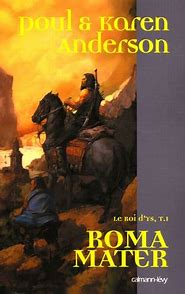Roma Mater, XXI, 3.
Gratillonius and Soren Cartagi converse - and, of course, the wind.
"Wind whooped." (p. 364)
Gratillonius stares out at the wind and, after heated argument:
"Again he turned away to the window and the wind." (p. 365)
Gratillonius, although King of Ys with sacral duties in the city, must travel around Armorica on Roman business:
"'...Rome must have one master, and he an able man. Can you not see?'" (p. 364)
"'A new age is upon Ys, upon the world.
"'Enough of provincial selfishness and dragging of feet.'" (p. 365)
But the new age will sweep everything away, including Ys and Rome. Gratillonius will prepare for the defence of his part of Europe after the destruction of Ys and the withdrawal of Rome. Describing changes at work between 1989 and 2012, I once said that, beyond the oncoming tsunami, there was a colliding planet.

9 comments:
All ages are "new".
Despite that, periods of fundamental change are fairly uncommon. Eg., the Crimean War was a major conflict and had consequences -- but it doesn't compare to the period between 1914 and 1945.
Likewise, the order put together after 1945 has basically endured down to the present: 1991 and the end of the Cold War basically just extended it to a larger geographic area.
The collapse of the Western Roman Empire -was- comparable to the World Wars of the last century, of course.
Kaor, Mr. Stirling!
And I sympathize with Gratillonius' impatience with provincial shortsightedness and foot dragging. He was trying to help prevent that collapse of the Western Roman Empire.
Ad astra! Sean
Sean: the Roman Empire was probably about as large as a state at that technological level could be.
At some point with governments you cease getting 'economies of scale' as their territory expands and start getting 'diseconomies' -- slow response times, for example.
(Which is why the Emperors after Diocletian kept experimenting with co-Emperors and subsidiary 'junior emperors'.)f
How big is best is in turn a function of things like the speed of communications and transportation, the sophistication of administrative technique, etc.
"like the speed of communications and transportation"
It's only recently that those became distinct.
Perhaps if a Galileo level telescope was possible with Roman level technology, a semaphore telegraph could have made communication faster than a running horse over the Empire.
Jim: yup. Though you don't actually need very advanced technology for the sort of electric telegraph produced in the 1830's and 1840's -- the primary chemical batteries used were crude and easily made. You could produce them at a fairly primitive level.
Kaor, Mr. Stirling!
Meaning, even in Antonine Rome, your stranded time travelers might be able to introduce telegraphy there???
Ad astra! Sean
Were the Romans up to making thousand of km of telegraph wire?
You mentioned the difficulty the Romans had with making *large* amount of iron. Wouldn't there be similar problems with other metals?
Similarly in discussions about replacing fossil fuels with energy source X, the difficulties of mining enough of material Y to do that are brought up.
Kaor, Jim!
I can't adequately comment, due to not knowing anything near enough about the practical details of telegraphy.
If I had to guess telegraphy was obsolete and falling out of use by 1970.
Ad astra! Sean
From SM Stirling:
Sean: transmitting digital code (which is what Morse code is) over wires certainly wasn't over by 1970!
Post a Comment